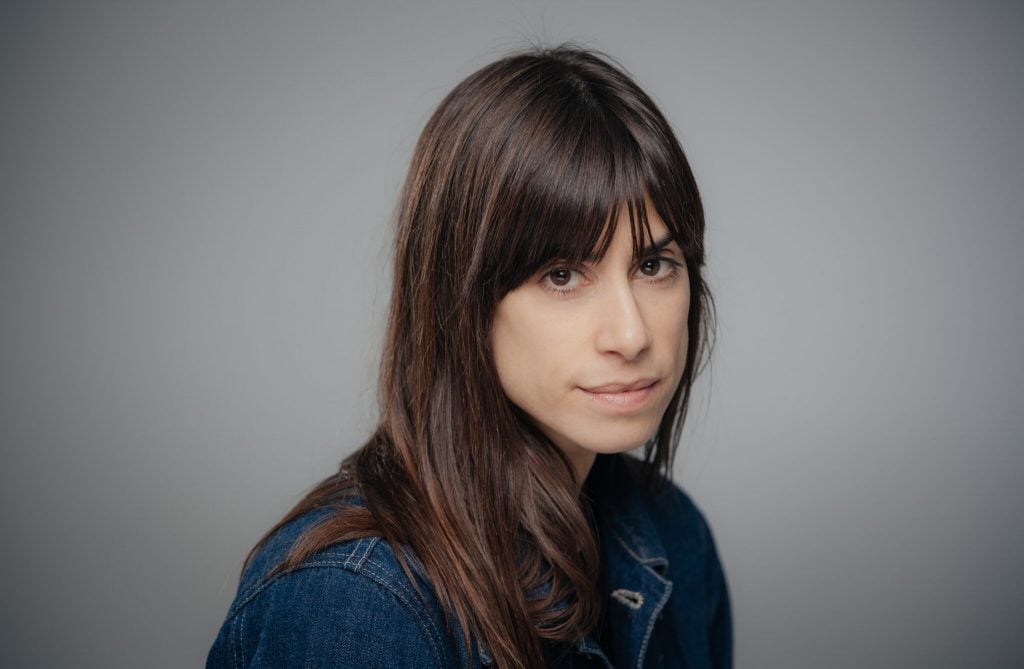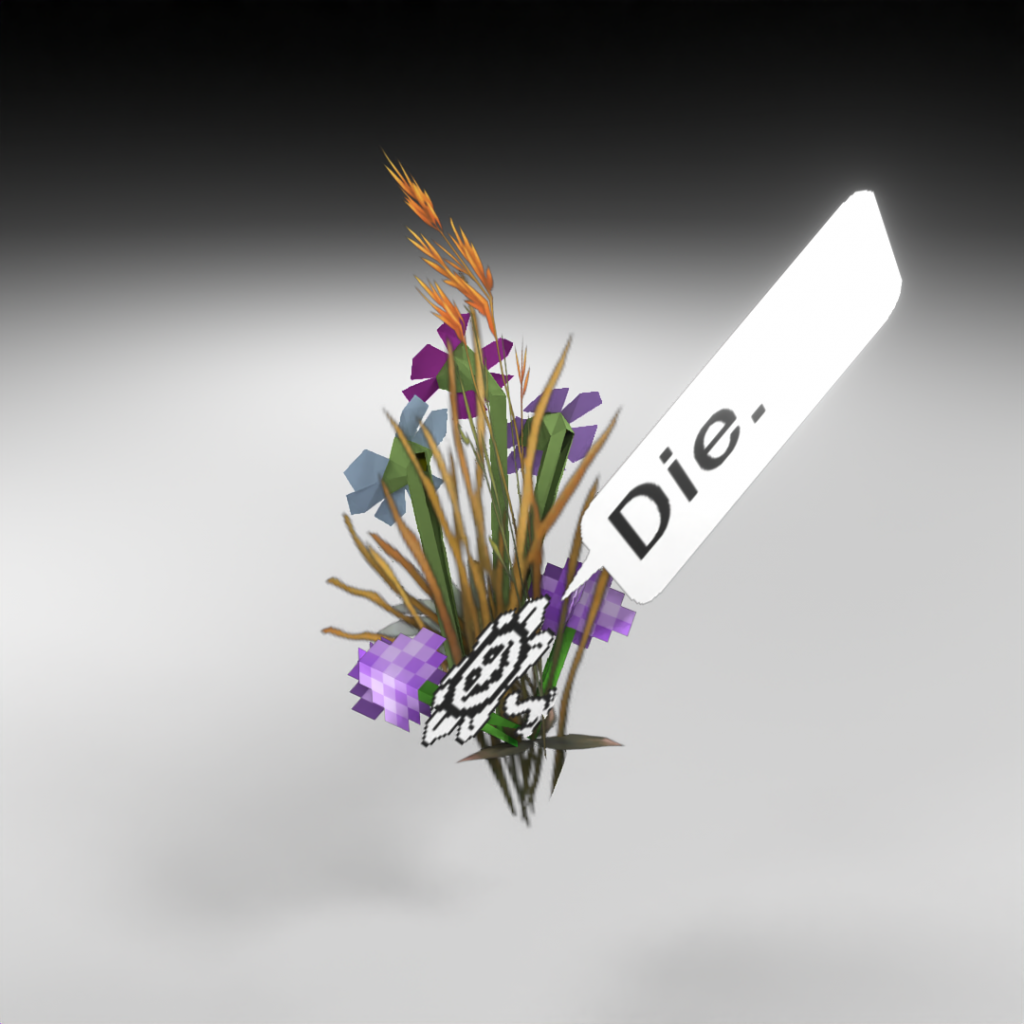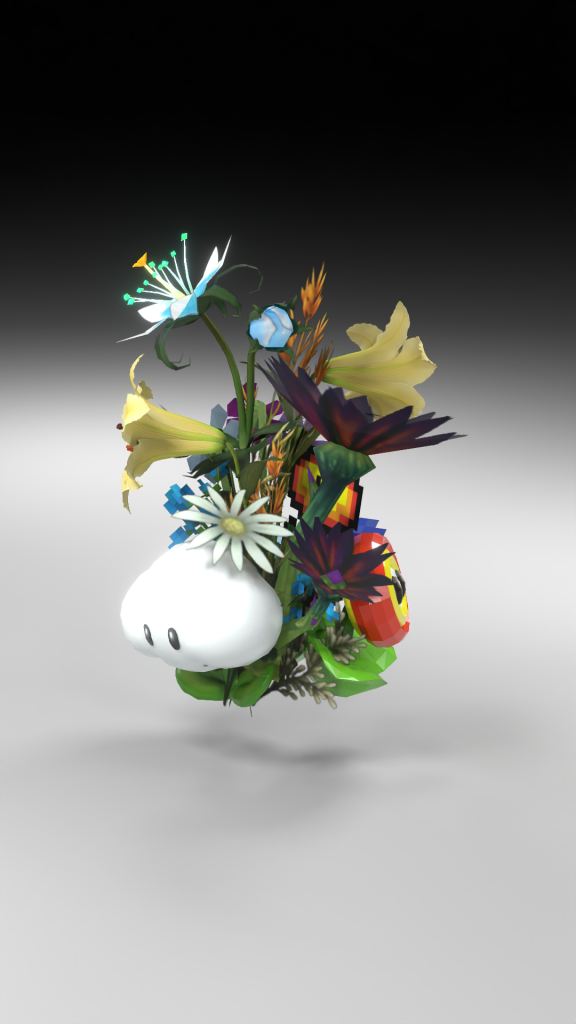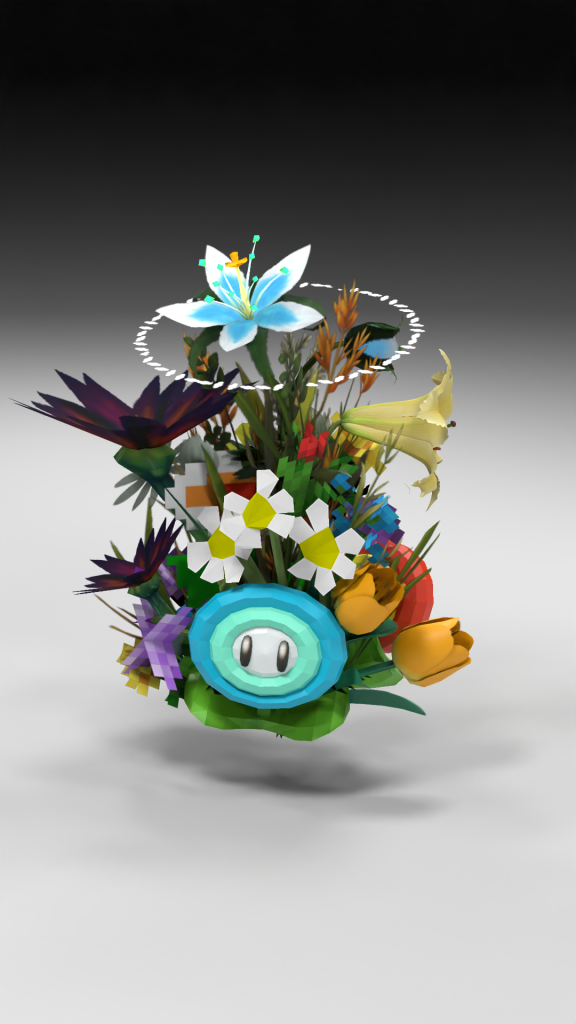NFTs
Jill Magid Is Selling NFT Bouquets Made of Flowers From ‘The Legend of Zelda,’ ‘World of Warcraft,’ and Other Video Games
“Out-Game Flowers” began as a reflection on how value moves between the digital and virtual worlds.

“Out-Game Flowers” began as a reflection on how value moves between the digital and virtual worlds.

Taylor Dafoe

A new kind of bouquet is available for purchase this Valentine’s Day—and each is filled with fake flowers filched from video games.
That’s the idea behind “Out-Game Flowers,” Jill Magid’s new—and first-ever—NFT project, minted through the young crypto-art platform Artwrld. Available starting today, the artist’s digital bouquets are comprised of flowers that were hacked, without permission, from the source codes of classic games including Final Fantasy, Minecraft, and more.
Each plant has a special value within its native virtual world. In Magid’s bouquets, you may find the Silent Princess from The Legend of Zelda series, which can be used for a stealth boost effect, or the Fire Flower from Super Mario Bros, which grants its users the power to throw balls of flame. Some flowers even have significant worth outside their games: So powerful is the Black Lotus from World of Warcraft, for instance, that players are sometimes willing to pay exorbitant real-world prices to get ahold of it.

A small bouquet from Jill Magid’s “Out-Game Flowers” NFT collection. Courtesy of the artist and Artwrld.
If you’re not already hooked by Magid’s conceit, consider some extra context. When it comes to established artists making NFTs, the truth is that the number of poorly thought-out projects far outweighs the interesting ones. But Magid, who said she “strongly dislikes the vast majority of NFTs,” doesn’t do anything that’s poorly thought-out. Whether she’s hijacking a public TV monitor or having herself surveilled by police, her work is always meticulously researched, and she often inserts herself into the very systems she’s interrogating.
In other words, if there was ever an artist to make an interesting NFT, it’s Magid.
The artist’s bouquets are, at face value, simple NFTs—which is to say that they look and act like digital collectibles, equal parts art object and speculative asset. But few elements in Magid’s practice are ever simple; knotty, complex systems are what she’s most interested in, and, sure enough, beneath the flowers are conceptual layers ready to be peeled away.

A large bouquet from Jill Magid’s “Out-Game Flowers” NFT collection. Courtesy of the artist and Artwrld.
To understand those layers, it’s helpful to understand the project’s genesis. It goes back to Tender, Magid’s 2020 Creative Time artwork, for which she laser-engraved the phrase “THE BODY WAS ALREADY SO FRAGILE” on the edge of 120,000 pennies.
Front of mind for the artist then was the ironic metaphorical contradiction between pandemic-era rhetoric around the struggling economy, which was often characterized as a financial “body” in need of resuscitation, and the rhetoric around human lives, so often reduced to data points on death toll graphs. To Magid, the ubiquitous penny—a financial token worth virtually nothing that suddenly became symbolically charged as a vector of transmission—symbolized the intersection of the bodily and the economic.
To disseminate the engraved pennies, Magid dropped them off, roll by roll, at bodegas around New York City. While doing so, she began to think about the flowers for sale outside so many of the stores. (She even recreated rows of bodega flowers for a Tender-related exhibition at the Modern Art Museum, Fort Worth.)
In her research, Magid learned that bodega flowers come from the same places as those found at upscale florists. Most are grown in industrialized farms in Europe or South America, then sent to the Netherlands to be graded on a scale based on criteria like stem length and blossom diameter. Low-graded flowers get shipped to New York’s corner stores, where they live only a few days. Many aren’t even purchased at all.
Magid learned that what we as consumers think of as a natural symbol of beauty, is, in fact, a carefully controlled asset propped up by a wasteful international economy. The plants “seemed like they were masking so many transactions and so many value systems inside of them,” she said.
It was at the height of her flower fascination that Nato Thompson, the curator and founding partner of Artwrld, approached the artist about doing an NFT project. “It’s a shame flowers don’t grow on the internet,” the she recalled telling Thompson.
“Well actually they do,” he replied, noting that flowers, like NFTs, symbolize a “merging of aesthetics and value.”

A small bouquet from Jill Magid’s “Out-Game Flowers” NFT collection. Courtesy of the artist and Artwrld.
“You know about Steven Bannon?” Thompson asked.
What the curator was referring to was gold farming, or the practice of hiring underpaid laborers in China and elsewhere to harvest rare, in-game items—as with World of Warcraft’s Black Lotus—to sell them outside the game for heavily marked-up prices. Before he became the editor of ultra-right news site Breitbart, Bannon served on the board, and then as CEO, for Internet Gaming Entertainment, a company built around this exploitative model.
With this bizarre story, the project suddenly clicked for Magid, and “Out-Game Flowers” was born. Though her NFTs look like straightforward bouquets, they represent something more: a convergence of multiple markets—those of videos games, blockchain art, and real-world flowers. “What I’m thinking through and really interested in is how different economies are working and how value is exchanged and transacted,” the artist explained.

A large bouquet from Jill Magid’s “Out-Game Flowers” NFT collection. Courtesy of the artist and Artwrld.
So, how much do Magid’s NFTs cost?
Some 150 of her 165 bouquets are smaller and run buyers $325 to $550. They’re priced to sell, the artist explained; as with pennies at a bodega, the goal is accessibility and quick circulation. As of publishing time, the smaller bouquets have already sold out.
The remaining 15 bouquets, meanwhile, are bigger—they contain one of every type of flower extracted by Magid’s team—and come with a price tag that is intentionally closer to that of a “traditional” gallery artwork: $10,000. (Paris’s Pompidou Center has already acquired one of the bigger bouquets, and Magid hopes other museums will too.)
For a project built on top of layer upon layer of thinking about exploitation, aesthetics, and the circulation of value in and between digital and IRL worlds, the market status of Magid’s blockchain bouquets is fairly conventional—status quo even
But for Thompson, that act of recapitulation is a feature, not a flaw. The project, he said, is “much more of a mirror than a critique.” In other words, “Out-Game Flowers” is meant to reflect the systems on which it’s based, not assess them.
“I would call this a soft re-presenting of the system to itself,” he said.